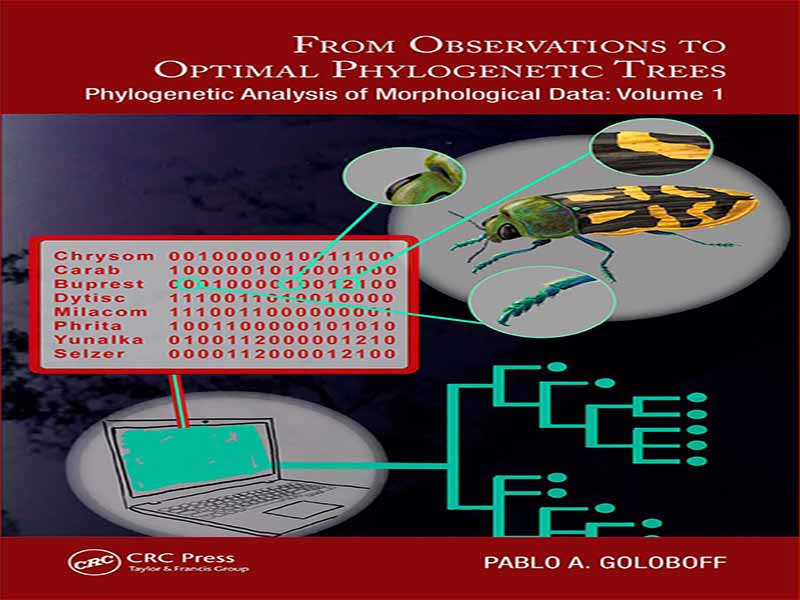- عنوان کتاب: From-Observations-to-Optimal-Phylogenetic-Trees/Phylogenetic-Analysis-of-Morphological-Data,-Volume-1
- نویسنده: Pablo-A.-Goloboff
- حوزه: تحلیل داده, ریخت شناسی
- سال انتشار: 2022
- تعداد صفحه: 298
- زبان اصلی: انگلیسی
- نوع فایل: pdf
- حجم فایل: 15.5 مگابایت
زمینه بازسازی فیلوژنتیک در چند دهه اخیر شاهد پیشرفت های شگرفی بوده است. منابع این پیشرفت ها از زیرشاخه های مختلف زیست شناسی (تکامل، ژنتیک، یا زیست شناسی مولکولی) و حتی خارج از زیست شناسی (علوم رایانه، ریاضیات، فلسفه) آمده است. اما تعدادی از مشارکتها در روششناسی فیلوژنتیک از سوی کارگرانی که عمدتاً به سیستماتیک و طبقهبندی علاقه دارند، آمده است. در اواخر دهه 60 و اوایل دهه 70، سیستم گرایان در ایجاد فیلوژنتیک به عنوان یک رشته مهم نقش داشتند. دیدگاه کلی محققان در سیستماتیک و طبقه بندی، و انواع مشکلاتی که آنها به آنها علاقه مند هستند، با دیدگاه افرادی که به فیلوژنتیک از زیست شناسی تکاملی یا علوم رایانه نزدیک می شوند، متفاوت است. نظامشناسان بیشتر بر روابط بین گونهها تمرکز میکنند، به تنوع بیشتر از ارگانیسمهای مدل علاقهمند هستند، و تمایل زیادی به تکیه بیشتر بر خصوصیات ریختشناسی دارند – که به عنوان بخشی از طبقهبندی استاندارد استفاده میشود. درعوض، فیلوژنتیک گرایان با گرایش به تکامل، تمایل دارند بر استفاده از درختان برای آزمایش فرضیه های خاص تمرکز کنند. هر دو نوع متفاوتی از مشکلات و زمینه های تحقیق مشروع هستند. ترجیحات شخصی منجر به تمرکز روی یک یا آن نوع مشکل می شود. بهعنوان فردی با تربیتی که ریشه در نظامشناسی و طبقهبندی دارد، احساس کردم که هیچ کتاب اخیر پیشرفتهای اصلی در این زمینه را از این منظر خلاصه نکرده است. این اولین دلیل برای نوشتن این کتاب است.
The field of phylogenetic reconstruction has seen tremendous advances in the last few decades. The sources for those advances have come from different subdisciplines of biology (evolution, genetics, or molecular biology) and even outside biology (computer science, mathematics, philosophy). But a number of the contributions to phylogenetic methodology have come from workers interested mostly in systematics and taxonomy. Systematists were instrumental in establishing phylogenetics as an important field in the late 60s and early 70s. The general outlook of researchers in systematics and taxonomy, and the kinds of problems they are interested in, tend to differ from those of people approaching phylogenetics from evolutionary biology or computer science. Systematists focus more on the relationships between species, are more interested in diversity than in model organisms, and tend to rely much more heavily on morphological characters—which are used as part of standard taxonomy. More evolutionarily oriented phylogeneticists, instead, tend to focus on the use of trees for testing specific hypotheses. Both are different kinds of problems and legitimate fields of inquiry; personal preferences lead to focusing on one or the other type of problem. As someone with an upbringing rooted in systematics and taxonomy, I felt that no recent book summarized the main advances in this field from this perspective. This is the first reason to write this book.
این کتاب را میتوانید از لینک زیر بصورت رایگان دانلود کنید:



































نظرات کاربران